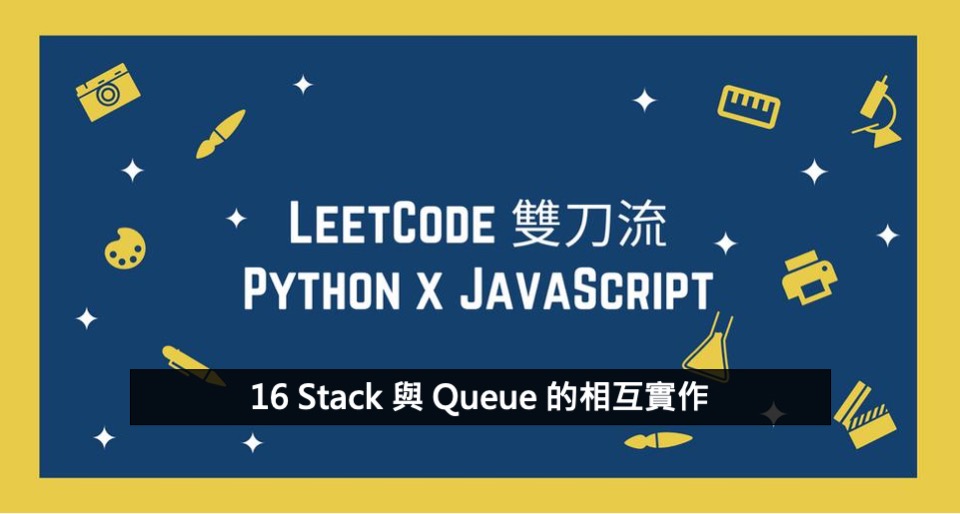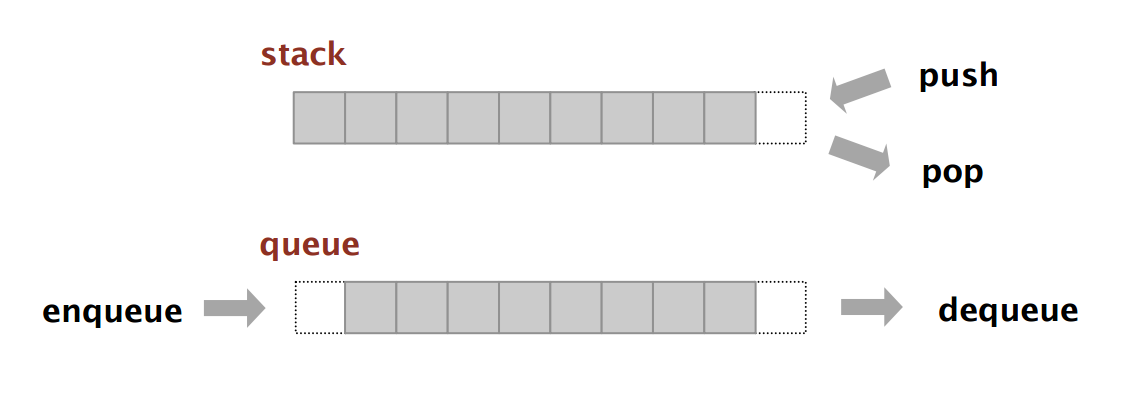
Implement a last-in-first-out (LIFO) stack using only two queues. The implemented stack should support all the functions of a normal stack (push, top, pop, and empty).
Implement a first in first out (FIFO) queue using only two stacks. The implemented queue should support all the functions of a normal queue (push, peek, pop, and empty).
這裡稍微補充說明一下,Stacks 和 Queues 是兩種方向不同的抽象資料結構(ADT)。如下圖所示,Stack 的特性是「FILO」,也就是說它提供同一個入口與出口,先被加入的元素會比較晚被取出。Queue 的特性是「FIFO」,也就是說它提供分別兩個入口與出口,從入口先被加入的元素會從出口比較早被取出。

更多細節可以參考 Algorithms - Stacks and Queues 內文。
class MyStack:
def __init__(self):
def push(self, x: int) -> None:
def pop(self) -> int:
def top(self) -> int:
def empty(self) -> bool:
class MyQueue:
def __init__(self):
def push(self, x: int) -> None:
def pop(self) -> int:
def peek(self) -> int:
def empty(self) -> bool:
# Your MyStack object will be instantiated and called as such:
obj = MyStack()
obj.push(x)
param_2 = obj.pop()
param_3 = obj.top()
param_4 = obj.empty()
# Your MyQueue object will be instantiated and called as such:
obj = MyQueue()
obj.push(x)
param_2 = obj.pop()
param_3 = obj.peek()
param_4 = obj.empty()
這個題目的形式類似於「填空題」,需要把題目中不同物件的細節補上。而這兩題想練習是「如何用 Stack 實作 Queue」以及「如何用 Queue 實作 Stack」。
在理解完題目與條件之後,那我們下一步就開始「#初探直覺解」並且一起嘗試「#刻意優化」的過程:
先來看 225. Implement Stack using Queues 這個題目,你需要知道這兩個結構擁有的特性以及限制:
根據題目中有特別提到的注意事項:
You must use only standard operations of a queue, which means that only push to back, peek/pop from front, size and is empty operations are valid.
簡單來說,本題僅可使用 Queue 資料結構作為來源 ,而在 Queue 當中有兩種標準定義的方法:
所以這個題目的限制是只能利用 Queue 的 peek 跟 push 方法實現 Stack 中的方法,初步的想法是在每次執行新增元素的時候,當將 Queue 中的元素倒序,可以達到「新加入的元素,將變成第一個被取出的元素」行為,也就是 FILO 的效果。
在 Python 中,我們會利用 [...] 代表 Queue,當中的 append(...) 用來 加入元素 、 [0]/pop(0) 用來 取出元素 。
class MyStack:
def __init__(self):
self.queue = []
def push(self, x: int) -> None:
self.queue.append(x)
for _ in range(len(self.queue)-1):
self.queue.append(self.queue[-1])
self.queue = self.queue.remove(self.queue[-1])
def pop(self) -> int:
return self.queue.pop(0)
def top(self) -> int:
return self.queue[0]
def empty(self) -> bool:
return not self.queue
在 JavaScript 中,我們會利用 [...] 代表 Queue,當中的 push(...) 用來 加入元素 、 [0]/shift() 用來 取出元素 。
var MyStack = function() {
this.queue = [];
};
MyStack.prototype.push = function(x) {
this.queue.push(x);
for(let i = 1; i < this.queue.length; i++){
this.queue.push(this.queue.shift());
}
};
MyStack.prototype.pop = function() {
return this.queue.shift();
};
MyStack.prototype.top = function() {
return this.queue[0];
};
MyStack.prototype.empty = function() {
return this.queue.length === 0;
};
先來看 232. Implement Queue using Stacks 這個題目,你需要知道這兩個結構擁有的特性以及限制:
根據題目中有特別提到的注意事項:
You must use only standard operations of a stack, which means only push to top, peek/pop from top, size, and is empty operations are valid.
簡單來說,本題僅可使用 Stack 資料結構作為來源 ,而在 Stack 當中有兩種標準定義的方法:
所以這個題目的限制是只能利用 Stack 的 pop 跟 push 方法實現 Queue 中的方法,初步的想法是在每次執行新增元素的時候,當將 Stack 中的元素倒序,可以達到「新加入的元素,將變成最後一個被取出的元素」行為,也就是 FILO 的效果。
在 Python 中,我們會利用 [...] 代表 stack,當中的 append(...) 用來 加入元素 、 [-1]/pop() 用來 取出元素 。
class MyQueue:
def __init__(self):
self.stack = []
def push(self, x):
swap = []
while self.stack:
swap.append(self.stack.pop())
swap.append(x)
while swap:
self.stack.append(swap.pop())
def pop(self) -> int:
return self.stack.pop()
def peek(self) -> int:
return self.stack[-1]
def empty(self) -> bool:
return not self.stack
在 JavaScript 中,我們會利用 [...] 代表 Queue,當中的 push(...) 用來 加入元素 、 [this.stack.length-1]/pop() 用來 取出元素 。
var MyQueue = function() {
this.stack = [];
};
MyQueue.prototype.push = function(x) {
swap = []
while(this.stack.length > 0)
swap.push(this.stack.pop());
swap.push(x)
while(swap.length > 0)
this.stack.push(swap.pop());
};
MyQueue.prototype.pop = function() {
return this.stack.pop();
};
MyQueue.prototype.peek = function() {
return this.stack[this.stack.length-1];
};
MyQueue.prototype.empty = function() {
return this.stack.length === 0;
};
這個題目是關於 Stack 和 Queue 的經典實作題,他們是兩種方向不同的抽象資料結構(ADT)。也就是說,我們會定義一個 Stack 或 Queue 需要有哪些方法與特性,但我們不會特別限制實際上如何實現,因此常見的方法可以利用陣列、陣列串鏈來實作。而這個題目比較特別的是,如何用 Stack 與 Queue 兩個結構相互實作。因此,必須要了解這兩個結構的特性與方法並且能夠進一步運用,才能更有效地完成該題目。
嗨,大家好!我是維元,一名擅長網站開發與資料科學的雙棲工程師,斜槓於程式社群【JSDC】核心成員及【資料科學家的工作日常】粉專經營。目前在 ALPHACamp 擔任資料工程師,同時也在中華電信、工研院與多所學校等單位持續開課。擁有多次大型技術會議講者與競賽獲獎經驗,持續在不同的平台發表對 #資料科學、 #網頁開發 或 #軟體職涯 相關的分享,邀請你加入 訂閱 接收最新資訊。

我當初還蠻喜歡這種題目,用不同的 ADT 實現另外一種 ADT,可以更理解不同 ADT 的性質,還有實作語言本身的特性和限制